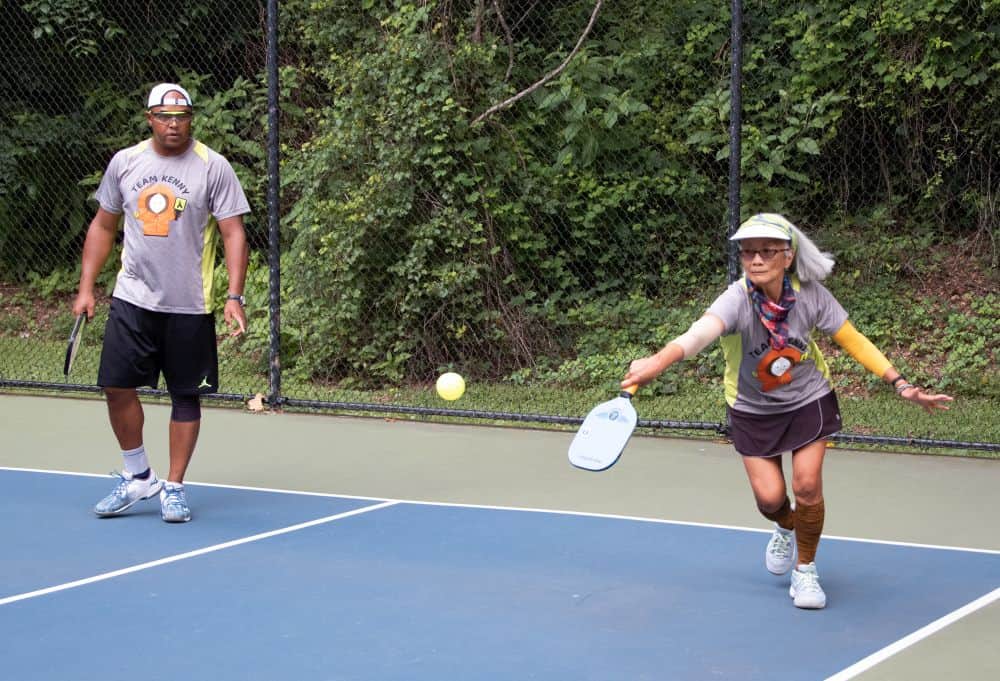
[Image above] For three years in a row, the Sports & Fitness Industry Association has named pickleball the fastest-growing sport in the United States. Ceramic materials are the basis for this sport’s top-tier paddles. Credit: Stephen Rahn, Flickr (Public Domain)
By Laurel Sheppard
March may have been all about basketball, but this month, it is pickleball’s time to shine.
Pickleball is a paddle sport that combines elements of tennis, badminton, and ping-pong. It is played either indoors or outdoors on a badminton-sized court using a slightly modified tennis net.
Pickleball traces its origin to 1965, when Washington state congressman Joel Prichard and businessman Bill Bell improvised the game using assorted sports equipment to entertain their bored families.
The name pickleball is a reference to the slang term “pickle boat” in competitive rowing, which describes a crew thrown together from the leftover rowers. (Just as pickleball was thrown together from the leftovers of other games.) There is a competing theory that the name is a nod to the Prichard family’s dog Pickles, but the family disputes this claim.
The popularity of pickleball exploded in recent years. Pickleball courts are being built right and left, and a report by the Association of Pickleball Professionals estimates more than 36.5 million people played the sport last year. Comedian Stephen Colbert hosted a celebrity pickleball event on CBS called Pickled, and Washington state governor Jay Inslee even signed a bill declaring pickleball the official state sport!
With April being National Pickleball Month, now is the perfect time to learn more about the U.S.’s fastest-growing sport and how ceramics push pickleball to the next level (as these materials do in many sports).
A brief timeline of pickleball history
- 1965. Pickleball “invented” in Bainbridge, Wash.
- Mid-1970s. Vacationers spread the game to places like Maui and Indonesia. Seattle school districts add it to their athletic programs.
- 1975. PickleBall, Inc. starts selling starter kits (paddles, balls, and a net) by mail order.
- 1976. The first pickleball tournament is held in Tukwila, Wash.
- 1978. The first book containing information on pickleball is published. (The Other Racquet Sports)
- 1984. The United States Amateur Pickleball Association is created, and the first rulebook is published.
- 1990. Pickleball is played in all 50 states. The Villages in Florida built its first permanent courts the year before.
- 1999. The first pickleball website, Pickleball Stuff, is launched.
- 2003. Pickleball is included for the first time in the Huntsman World Senior Games held in Utah.
- 2005. The USA Pickleball Association is established.
- 2008. Pickleball is included for the first time at the National Senior Games Association, and the number of places to play in North America reaches 420.
- 2009. The first USA Pickleball Association National Tournament is played in Arizona, featuring almost 400 players.
- 2010. The USAPA establishes the International Federation of Pickleball. (The Federation now has more than 60 member countries.)
- 2015. The International Pickleball Teaching Professional Association is created.
- 2016. Pickleball Magazine is launched, and the first U.S. Open Pickleball Championships are held in Florida.
- 2017. The first International Bainbridge Cup tournament is held in Spain, and the Pickleball Hall of Fame is created.
- 2019. The Association of Pickleball Professionals Tour is launched in June, becoming the first USA Pickleball Sanctioned Tour for professionals and amateurs.
- 2020. The History of Pickleball book, published in 2018, wins the National Indie Excellence Award.
- 2021. Membership in USA Pickleball reaches more than 53,000 members, a 43% increase from the previous year. (The organization now has more than 70,000 members.)
- 2022. Tom Dundon, owner of the NHL’s Carolina Hurricanes, buys the Pro Pickleball Association, retailer Pickleball Central, and pickleballtournaents.com. LeBron James and other professional athletes buy ownership stakes in professional pickleball teams.
- 2023. Major League Pickleball expands from 12 to 16 teams, with six tournaments and more than $2 million in prizes.
Ceramics at play in pickleball paddles
What was once a simple wooden paddle has morphed into paddles with faces made from high-tech materials, including ceramics. The face material determines how heavy the paddle is and what type of player should use them. (For a classification of paddle types, see here.)
- Composite-faced paddles, typically fiberglass reinforced, are one of the most common paddle face types. They are suitable for all levels, including power and spin players.
- Graphite-faced paddles, which incorporate a thin layer of graphite on the paddle’s core, are lightweight and best for control players.
- Carbon-fiber-faced paddles are a recent addition to the game, resulting in extremely durable paddles. Thus, they are suitable for power players and those who “abuse” their paddles.
- Hybrid-faced paddles combine several materials, including all those previously discussed, and are suitable for all-around players.
Materials used in the core of a pickleball paddle also affect a player’s game, as described here. The core is honeycomb structured (cells can vary in size) and made from a variety of materials, including polymer (polypropylene), aluminum, and Nomex (polymer-based material invented by DuPont and originally used in aircraft construction). The thickness of the core material should also be considered.
The shape of the paddle face and handle length are important factors in game play as well.
Most pickleball paddles range in price from $60 to $230. Aluminum-faced paddles are some of the least expensive and so are a good choice for beginners or recreational players looking for an inexpensive option. Once a player decides to invest in the game, however, they should choose one of the other options.
For the latest on pickleball paddles, see this review.
Join the movement
Interested in giving pickleball a try? USA Pickleball provides an up-to-date and comprehensive listing of places to play pickleball at places2play.org. Plus, check out how USA Pickleball plans to celebrate National Pickleball Month!
